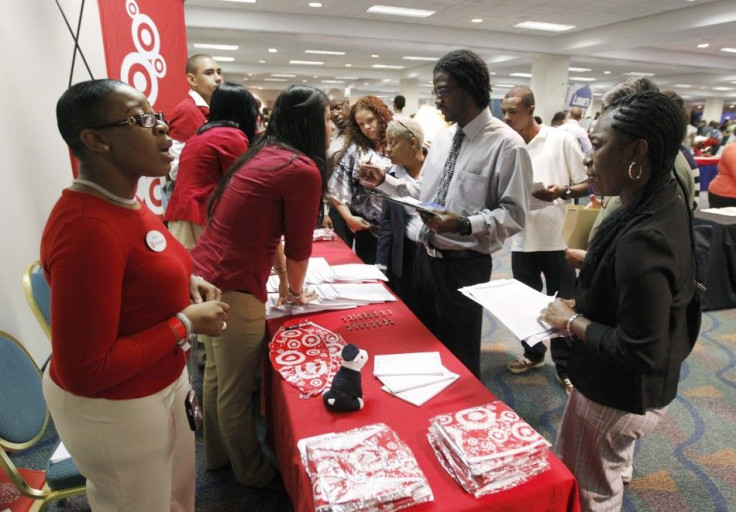These Signs Say The US Labor Market Is Healing

While all the headlines in recent months have been devoted to highlighting the "sluggishness" of job creation, the U.S. labor market is in fact actively stitching together its wounds. So says Eric Lascelles, chief economist at RBC Global Asset Management.
"This labor-market rehabilitation is easy to overlook. After all, the main symptom of the past few months has been one of decelerating job creation. But a more comprehensive checkup still uncovers evidence of active healing," Lascelles said.
The U.S. suffered epic job losses during the 2008-2009 financial crisis. From peak to trough, nearly 9 million American jobs evaporated.
Since then, the U.S. economy has clawed its way back to growth, enabling the job market to rebound off its early 2010 nadir. The unemployment rate has dropped by two percentage points since 2009, and almost 4 million lost jobs have been restored.
Economists polled by Reuters expect non-farm payroll employment to increase by 100,000 in July -- slightly better than the 80,000 gain seen in June. The official number is due on Aug.3.
While this would still mean that employment is not growing at a rate fast enough to reduce the unemployment rate from the 8.2 percent figure in June, there are some indications that job growth may accelerate in the months ahead.
In the July issue of Economic Compass published Friday, Lascelles provided a myriad of metrics to support his view that the labor market recovery is making notable progress.
More strikes. Work stoppages are reverting to normal levels after a period of unusual calm.
"We've even seen the number of strikes pick up," Lascelles said. "That might seem to be a strange thing to celebrate, but it suggests that labor is detecting a shift in the balance of power. They are feeling more comfortable in their employment, perhaps in alternative job prospects."
In New York, Consolidated Edison, Inc. (NYSE: ED) and its union struck a deal Thursday to end the three-week lockout of 8,000 workers, Gov. Andrew Cuomo announced.
Earlier Thursday, the union said about half of the 8,000 members of Local 1-2 of the Utility Workers of America, who have been locked out since June 30, will return to work immediately to help the utility prepare for coming severe storms and deal with emergencies.
Meanwhile, the machinists' strike at the Joliet, Ill., plant of Caterpillar Inc. (NYSE: CAT) is extending into its 13th week.
Despite earning a record $4.9 billion profit last year and projecting even better results for 2012, the company is insisting on a six-year wage freeze and a pension freeze for most of the 780 production workers at its Joliet plant. Caterpillar says it needs to keep its labor costs down to ensure its future competitiveness.
In April, the International Association of Machinists and Aerospace Workers voted 504-116 to reject the pact Caterpillar offered. Machinists later rejected a second offer that included a $1,000 signing bonus.
Improving labor market conditions. The labor-market conditions index confirms that the job market is substantially off its lows, but still quite far from target. In fact, its present positioning is in line with the worst readings from earlier, more pedestrian recessions, Lascelles said.
Positive labor market momentum. The labor-market momentum index captures the rate of improvement in the job market.
"Fortunately, it confirms that an important rebound is indeed occurring, with forward progress across virtually all inputs," Lascelles said. "However, it is coming at a slightly slower rate than past recoveries."
Across-the-board hiring. RBC Global Asset Management's index of hiring breadth gauges how broadly based hiring is across sectors, states, age groups, educational backgrounds and individual companies.
"There's remarkably good breadth to job creation right now," Lascelles said. "This is not just one sector going like gangbusters. This is fairly broad hiring and it's actually fairly good quality hiring as well."
Better job quality. This measure of job quality differentiates between full-time and part-time jobs, and distinguishes between sectors based on their average salaries.
While the quality-adjusted rate of hiring appeared a hair worse than official reports at the bottom of the cycle, the trend has begun to reverse.
"Job quality has been quite good of late, arguably worth the equivalent of 50,000 additional jobs per month," Lascelles said.
Working more hours per week. The U.S. achieved muscular productivity gains in the early stages of the recovery by working downtrodden employees extra hard. And they have not yet eased up.
Lascelles pointed out that the employees of goods-producing firms are working an unusually high number of hours per week.
"Reverting hours worked to more normal levels would enable the addition of another 275,000 workers," Lascelles said. "Extending this effect across the entire economy might boost achievable job creation to as many as 150,000 positions per month."
Businesses testing the water. Companies frequently begin by hiring temporary workers, and as their confidence grows, they become more comfortable hiring permanent workers.
"There is a four-month lead time from one to the other. It is thus quite positive that temporary job growth has accelerated to a heady 11 percent per year," Lascelles said.
Based on the recent rebound in the change in temporary payrolls from an average rise of 4,000 in the three months to April to 22,000 in the three months to June, permanent payrolls may soon start to grow at a faster rate.
"One of these days, in several years' time, we are all going to wake up ... and realize the U.S. economy basically healed itself and it's ready for business," Lascelles said. "That's fairly distant, but that healing is happening."
© Copyright IBTimes 2024. All rights reserved.












